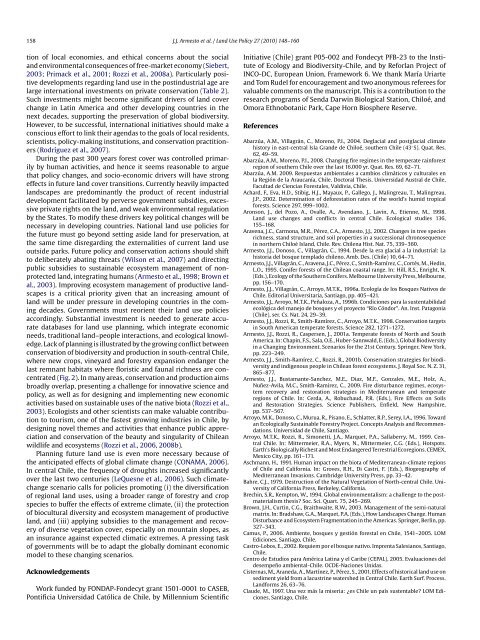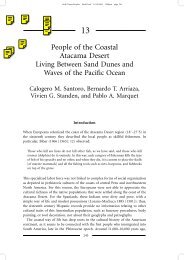Armesto et al LUP 2010.pdf - IEB
Armesto et al LUP 2010.pdf - IEB
Armesto et al LUP 2010.pdf - IEB
You also want an ePaper? Increase the reach of your titles
YUMPU automatically turns print PDFs into web optimized ePapers that Google loves.
158 J.J. <strong>Armesto</strong> <strong>et</strong> <strong>al</strong>. / Land Use Policy 27 (2010) 148–160tion of loc<strong>al</strong> economies, and <strong>et</strong>hic<strong>al</strong> concerns about the soci<strong>al</strong>and environment<strong>al</strong> consequences of free-mark<strong>et</strong> economy (Siebert,2003; Primack <strong>et</strong> <strong>al</strong>., 2001; Rozzi <strong>et</strong> <strong>al</strong>., 2008a). Particularly positivedevelopments regarding land use in the postindustri<strong>al</strong> age arelarge internation<strong>al</strong> investments on private conservation (Table 2).Such investments might become significant drivers of land coverchange in Latin America and other developing countries in thenext decades, supporting the preservation of glob<strong>al</strong> biodiversity.However, to be successful, internation<strong>al</strong> initiatives should make aconscious effort to link their agendas to the go<strong>al</strong>s of loc<strong>al</strong> residents,scientists, policy-making institutions, and conservation practitioners(Rodríguez <strong>et</strong> <strong>al</strong>., 2007).During the past 300 years forest cover was controlled primarilyby human activities, and hence it seems reasonable to argu<strong>et</strong>hat policy changes, and socio-economic drivers will have strongeffects in future land cover transitions. Currently heavily impactedlandscapes are predominantly the product of recent industri<strong>al</strong>development facilitated by perverse government subsidies, excessiveprivate rights on the land, and weak environment<strong>al</strong> regulationby the States. To modify these drivers key politic<strong>al</strong> changes will benecessary in developing countries. Nation<strong>al</strong> land use policies forthe future must go beyond s<strong>et</strong>ting aside land for preservation, atthe same time disregarding the extern<strong>al</strong>ities of current land useoutside parks. Future policy and conservation actions should shiftto deliberately abating threats (Wilson <strong>et</strong> <strong>al</strong>., 2007) and directingpublic subsidies to sustainable ecosystem management of nonprotectedland, integrating humans (<strong>Armesto</strong> <strong>et</strong> <strong>al</strong>., 1998; Brown <strong>et</strong><strong>al</strong>., 2003). Improving ecosystem management of productive landscapesis a critic<strong>al</strong> priority given that an increasing amount ofland will be under pressure in developing countries in the comingdecades. Governments must reorient their land use policiesaccordingly. Substanti<strong>al</strong> investment is needed to generate accuratedatabases for land use planning, which integrate economicneeds, tradition<strong>al</strong> land–people interactions, and ecologic<strong>al</strong> knowledge.Lack of planning is illustrated by the growing conflict b<strong>et</strong>weenconservation of biodiversity and production in south-centr<strong>al</strong> Chile,where new crops, vineyard and forestry expansion endanger thelast remnant habitats where floristic and faun<strong>al</strong> richness are concentrated(Fig. 2). In many areas, conservation and production aimsbroadly overlap, presenting a ch<strong>al</strong>lenge for innovative science andpolicy, as well as for designing and implementing new economicactivities based on sustainable uses of the native biota (Rozzi <strong>et</strong> <strong>al</strong>.,2003). Ecologists and other scientists can make v<strong>al</strong>uable contributionto tourism, one of the fastest growing industries in Chile, bydesigning novel themes and activities that enhance public appreciationand conservation of the beauty and singularity of Chileanwildlife and ecosystems (Rozzi <strong>et</strong> <strong>al</strong>., 2006, 2008b).Planning future land use is even more necessary because ofthe anticipated effects of glob<strong>al</strong> climate change (CONAMA, 2006).In centr<strong>al</strong> Chile, the frequency of droughts increased significantlyover the last two centuries (LeQuesne <strong>et</strong> <strong>al</strong>., 2006). Such climatechangescenario c<strong>al</strong>ls for policies promoting (i) the diversificationof region<strong>al</strong> land uses, using a broader range of forestry and cropspecies to buffer the effects of extreme climate, (ii) the protectionof biocultur<strong>al</strong> diversity and ecosystem management of productiveland, and (iii) applying subsidies to the management and recoveryof diverse veg<strong>et</strong>ation cover, especi<strong>al</strong>ly on mountain slopes, asan insurance against expected climatic extremes. A pressing taskof governments will be to adapt the glob<strong>al</strong>ly dominant economicmodel to these changing scenarios.AcknowledgementsWork funded by FONDAP-Fondecyt grant 1501-0001 to CASEB,Pontificia Universidad Católica de Chile, by Millennium ScientificInitiative (Chile) grant P05-002 and Fondecyt PFB-23 to the Instituteof Ecology and Biodiversity-Chile, and by Reforlan Project ofINCO-DC, European Union, Framework 6. We thank María Uriarteand Tom Rudel for encouragement and two anonymous referees forv<strong>al</strong>uable comments on the manuscript. This is a contribution to theresearch programs of Senda Darwin Biologic<strong>al</strong> Station, Chiloé, andOmora Ethnobotanic Park, Cape Horn Biosphere Reserve.ReferencesAbarzúa, A.M., Villagrán, C., Moreno, P.I., 2004. Deglaci<strong>al</strong> and postglaci<strong>al</strong> climatehistory in east-centr<strong>al</strong> Isla Grande de Chiloé, southern Chile (43 ◦ S). Quat. Res.62, 49–59.Abarzúa, A.M., Moreno, P.I., 2008. Changing fire regimes in the temperate rainforestregion of southern Chile over the last 16.000 yr. Quat. Res. 69, 62–71.Abarzúa, A.M. 2009. Respuestas ambient<strong>al</strong>es a cambios climáticos y cultur<strong>al</strong>es enla Región de la Araucanía, Chile. Doctor<strong>al</strong> Thesis. Universidad Austr<strong>al</strong> de Chile,Facultad de Ciencias Forest<strong>al</strong>es, V<strong>al</strong>divia, Chile.Achard, F., Eva, H.D., Stibig, H.J., Mayaux, P., G<strong>al</strong>lego, J., M<strong>al</strong>ingreau, T., M<strong>al</strong>ingreau,J.P., 2002. D<strong>et</strong>ermination of deforestation rates of the world’s humid tropic<strong>al</strong>forests. Science 297, 999–1002.Aronson, J., del Pozo, A., Ov<strong>al</strong>le, A., Avendano, J., Lavin, A., Etienne, M., 1998.Land use changes and conflicts in centr<strong>al</strong> Chile. Ecologic<strong>al</strong> studies 136,155–168.Aravena, J.C., Carmona, M.R., Pérez, C.A., <strong>Armesto</strong>, J.J., 2002. Changes in tree speciesrichness, stand structure, and soil properties in a succession<strong>al</strong> chronosequencein northern Chiloé Island, Chile. Rev. Chilena Hist. Nat. 75, 339–360.<strong>Armesto</strong>, J.J., Donoso, C., Villagrán, C., 1994. Desde la era glaci<strong>al</strong> a la industri<strong>al</strong>: Lahistoria del bosque templado chileno. Amb. Des. (Chile) 10, 64–71.<strong>Armesto</strong>, J.J., Villagrán, C., Aravena, J.C., Pérez, C., Smith-Ramírez, C., Cortés, M., Hedin,L.O., 1995. Conifer forests of the Chilean coast<strong>al</strong> range. In: Hill, R.S., Enright, N.(Eds.), Ecology of the Southern Conifers. Melbourne University Press, Melbourne,pp. 156–170.<strong>Armesto</strong>, J.J., Villagrán, C., Arroyo, M.T.K., 1996a. Ecología de los Bosques Nativos deChile. Editori<strong>al</strong> Universitaria, Santiago, pp. 405–421.<strong>Armesto</strong>, J.J., Arroyo, M.T.K., Peñ<strong>al</strong>oza, A., 1996b. Condiciones para la sustentabilidadecológica del manejo de bosques y el proyecto “Río Cóndor”. An. Inst. Patagonia(Chile), ser. Cs. Nat. 24, 29–39.<strong>Armesto</strong>, J.J., Rozzi, R., Smith-Ramírez, C., Arroyo, M.T.K., 1998. Conservation targ<strong>et</strong>sin South American temperate forests. Science 282, 1271–1272.<strong>Armesto</strong>, J.J., Rozzi, R., Caspersen, J., 2001a. Temperate forests of North and SouthAmerica. In: Chapin, F.S., S<strong>al</strong>a, O.E., Huber-Sannw<strong>al</strong>d, E. (Eds.), Glob<strong>al</strong> Biodiversityin a Changing Environment. Scenarios for the 21st Century. Springer, New York,pp. 223–249.<strong>Armesto</strong>, J.J., Smith-Ramírez, C., Rozzi, R., 2001b. Conservation strategies for biodiversityand indigenous people in Chilean forest ecosystems. J. Roy<strong>al</strong> Soc. N. Z. 31,865–877.<strong>Armesto</strong>, J.J., Bustamante-Sanchez, M.E., Diaz, M.F., Gonz<strong>al</strong>es, M.E., Holz, A.,Nuñez-Avila, M.C., Smith-Ramirez, C., 2009. Fire disturbance regimes, ecosystemrecovery and restoration strategies in Mediterranean and temperateregions of Chile. In: Cerda, A., Robuchaud, P.R. (Eds.), Fire Effects on Soilsand Restoration Strategies. Science Publishers, Enfield, New Hampshire,pp. 537–567.Arroyo, M.K., Donoso, C., Murua, R., Pisano, E., Schlatter, R.P., Serey, I.A., 1996. Towardan Ecologic<strong>al</strong>ly Sustainable Forestry Project. Concepts An<strong>al</strong>ysis and Recommendations.Universidad de Chile, Santiago.Arroyo, M.T.K., Rozzi, R., Simon<strong>et</strong>ti, J.A., Marqu<strong>et</strong>, P.A., S<strong>al</strong>laberry, M., 1999. Centr<strong>al</strong>Chile. In: Mittermeier, R.A., Myers, N., Mittermeier, C.G. (Eds.), Hotspots.Earth’s Biologic<strong>al</strong>ly Richest and Most Endangered Terrestri<strong>al</strong> Ecoregions. CEMEX,Mexico City, pp. 161–171.Aschmann, H., 1991. Human impact on the biota of Mediterranean-climate regionsof Chile and C<strong>al</strong>ifornia. In: Groves, R.H., Di Castri, F. (Eds.), Biogeography ofMediterranean Invasions. Cambridge University Press, pp. 33–42.Bahre, C.J., 1979. Destruction of the Natur<strong>al</strong> Veg<strong>et</strong>ation of North-centr<strong>al</strong> Chile. Universityof C<strong>al</strong>ifornia Press, Berkeley, C<strong>al</strong>ifornia.Brechin, S.R., Kempton, W., 1994. Glob<strong>al</strong> environment<strong>al</strong>ism: a ch<strong>al</strong>lenge to the postmateri<strong>al</strong>ismthesis? Soc. Sci. Quart. 75, 245–269.Brown, J.H., Curtin, C.G., Braithwaite, R.W., 2003. Management of the semi-natur<strong>al</strong>matrix. In: Bradshaw, G.A., Marqu<strong>et</strong>, P.A. (Eds.), How Landscapes Change. HumanDisturbance and Ecosystem Fragmentation in the Americas. Springer, Berlin, pp.327–343.Camus, P., 2006. Ambiente, bosques y gestión forest<strong>al</strong> en Chile, 1541–2005. LOMEdiciones, Santiago, Chile.Castro-Lobos, E., 2002. Requiem por el bosque nativo. Imprenta S<strong>al</strong>esianos, Santiago,Chile.Centro de Estudios para América Latina y el Caribe (CEPAL), 2005. Ev<strong>al</strong>uaciones deldesempeño ambient<strong>al</strong>-Chile. OCDE-Naciones Unidas.Cisternas, M., Araneda, A., Martínez, P., Pérez, S., 2001. Effects of historic<strong>al</strong> land use onsediment yield from a lacustrine watershed in Centr<strong>al</strong> Chile. Earth Surf. Process.Landforms 26, 63–76.Claude, M., 1997. Una vez más la miseria: ¿es Chile un país sustentable? LOM Ediciones,Santiago, Chile.
















